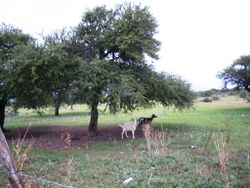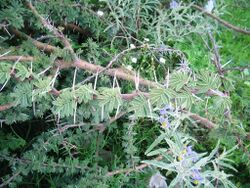Biology:Vachellia schaffneri
| Vachellia schaffneri | |
|---|---|

| |
| Vachellia schaffneri fruits | |
| Scientific classification | |
| Kingdom: | Plantae |
| Clade: | Tracheophytes |
| Clade: | Angiosperms |
| Clade: | Eudicots |
| Clade: | Rosids |
| Order: | Fabales |
| Family: | Fabaceae |
| Subfamily: | Caesalpinioideae |
| Clade: | Mimosoid clade |
| Genus: | Vachellia |
| Species: | V. schaffneri
|
| Binomial name | |
| Vachellia schaffneri (S. Watson) Seigler & Ebinger
| |
| Synonyms | |
| |
Vachellia schaffneri, the twisted acacia or Schaffner's acacia, is a tree native to Mexico and the southwestern United States (Texas ).[1]
Description
This is a thorny tree growing up to 25 feet in height. It has alternate, bipinnately compound leaves that are generally similar to those of other Vachellia species. The plant flowers in spring, with yellow mimosoid flowers. The seedpods are long, fuzzy, ripen in late summer, and are consumed by livestock. They contain many hard, black seeds.
Uses
Vachellia schaffneri wood is used for fuel and fences. The wood makes very good firewood. It is used for cooking.
Vachellia schaffneri trees serve as food for animals. Goats and sheep browse leaves from the tree and eat the fuzzy beans when available late in the summer. Livestock use the trees for shade and shelter.
Chemical compounds
Some chemical compounds found in Vachellia schaffneri are:
The foliage and seeds of Vachellia schaffneri have a protein content of about 11.6%.[3]
References
Notes
External links
Wikidata ☰ Q4671005 entry
 |




